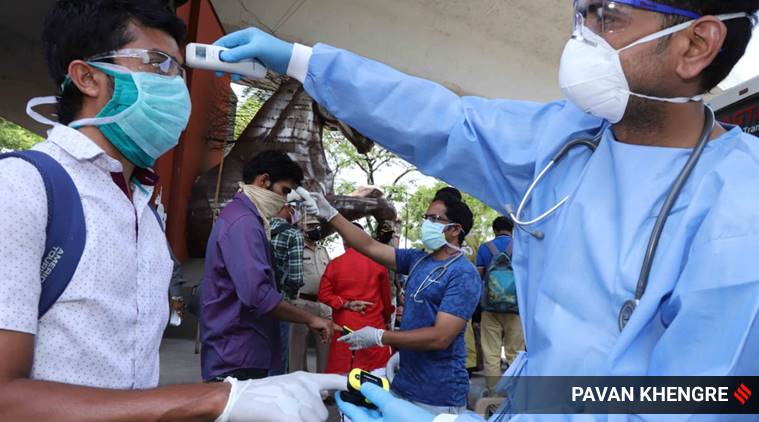- India
- International
Virus spread slowing, key reproduction number 1.29 until May 10
The transmission rate is driven mostly by outbreaks in a few states, while most states saw contained growth. At the beginning of lockdown, the R-naught (indicating the initial transmission rate) for March 27-April 6 was 1.83.
 The states which are seeing exponential case growth are Maharashtra, Tamil Nadu, Gujarat, Delhi and West Bengal.
The states which are seeing exponential case growth are Maharashtra, Tamil Nadu, Gujarat, Delhi and West Bengal.
Between April 13 and May 10, the Covid-19 transmission rate (represented by the basic reproduction number or R-number) remained steady at 1.29, even after some of the lockdown restrictions were eased on May 4, according to a study done by the Institute of Mathematical Sciences, Chennai.
The transmission rate is driven mostly by outbreaks in a few states, while most states saw contained growth. At the beginning of lockdown, the R-naught (indicating the initial transmission rate) for March 27-April 6 was 1.83. In the study of infectious disease, the basic reproduction number (R0 in the beginning, and then R-number) is used to assess the severity of an outbreak. This number is an average, reflecting the number of people infected by one infected person. The current R-number of 1.29 means that a Covid-19 patient is infecting 1.29 other people on an average.
“There has been remarkably little variation in the rate April 13 onwards,” said researcher Sitabhra Sinha.
The new data captures the trend a week after some restrictions were eased on April 20, and then again on May 4.
At this current pace, India may see 70,000-80,000 active cases by May 17, Sinha said. The number of active cases on Tuesday was 46,008.
The states which are seeing exponential case growth are Maharashtra, Tamil Nadu, Gujarat, Delhi and West Bengal.

Among the 10 states which have the highest case count (Maharashtra, Gujarat, Tamil Nadu, Delhi, Rajasthan, Madhya Pradesh, Uttar Pradesh, West Bengal, Andhra Pradesh, Punjab), Tamil Nadu has the highest R-number at 2.01. The state saw its numbers surpass that of Delhi this week, primarily due to a cluster in Chennai’s Koyambedu market as well as an expansion of testing to 3.37 tests per thousand people.
Punjab has also seen a surge to a 1.32 R-number, partly due to the pilgrims who returned from Nanded testing positive; the state’s testing figures stand at 1.42 per thousand people.
In this group, four states with the largest outbreaks – Maharashtra, Gujarat, Tamil Nadu and Delhi – account for two-thirds of India’s case load.
 In this group, four states with the largest outbreaks – Maharashtra, Gujarat, Tamil Nadu and Delhi – account for two-thirds of India’s case load.
In this group, four states with the largest outbreaks – Maharashtra, Gujarat, Tamil Nadu and Delhi – account for two-thirds of India’s case load.
While West Bengal’s total case count remains relatively low (2,063), the state has seen a fluctuating R-number – 1.51 in April-end, 1.14 in May-beginning, 1.34 till May 10. The state also has a low testing rate (.45 tests per thousand people).
Barring Tamil Nadu, the other southern states have seen almost linear growth. For example, although Andhra Pradesh is in the top 10 states by case count, it has curtailed its growth with a high testing rate (3.47 per thousand people). Kerala is also now a well-known example of a flattened curve.
Some states with a large number of active cases – Uttar Pradesh, Madhya Pradesh and Rajasthan – are showing “sub-exponential” growth, meaning moderate spread. Rajasthan’s testing proportion is moderate (2.15 per thousand), but Uttar Pradesh (.58 per thousand) and Madhya Pradesh (.92 per thousand) are testing relatively fewer people.
In the east, Bihar and Odisha have seen recent upswings, partly due to cases among migrants arriving home. Bihar’s testing proportion remains low (.29 per thousand) while Odisha has steadily increased its capacity (1.37 per thousand).
While the third phase of the lockdown is scheduled to end on May 17, Sinha cautioned that “in the absence of other containment measures, a lockdown by itself may be insufficient to prevent the epidemic from growing again once the stringent restrictions on movement of people are removed.”
AIIMS Director Dr Randeep Guleria, who is part of the core team monitoring the pandemic in India, had earlier said that the curve was still rising (meaning an R-number higher than 1). “The number of cases is still increasing everyday. But the rise of the curve is not so sharp that we cannot handle it,” Guleria said.
Must Read
Apr 23: Latest News
- 01
- 02
- 03
- 04
- 05




































